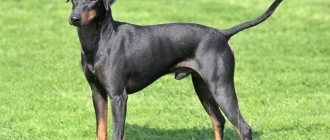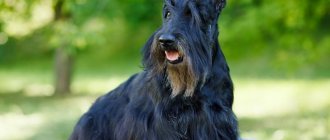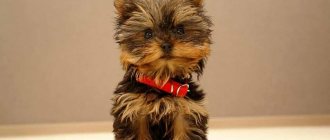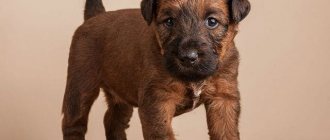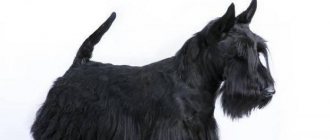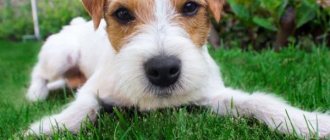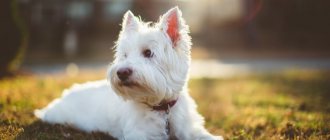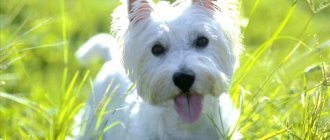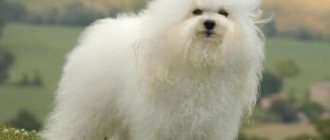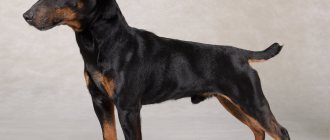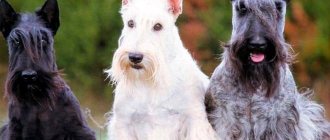Despite its two-hundred-year history, Norfolk Terriers are not the most common dog breed. Most of these terriers live in their homeland, Great Britain. Now their popularity in other countries is growing, and this is understandable. Thanks to their compact size, Norfolk Terriers can be kept even in a small apartment and taken with you on trips. Let's figure out what conditions need to be created for this breed.
History of the origin of the breed
The homeland of the Norfolk Terrier is the eastern part of Great Britain, the county of Norfolk. They were first bred at the end of the 19th century for burrow hunting. Initially, Norwich Terriers were also included in this group, but since 1964 the dogs have been divided into different breeds of the same group. Today, Norfolk dogs are rare, despite several centuries of active breeding, they have not lost their hunting skills, playfulness and ability to learn.
Photo: wikimedia.org
Interesting Facts
Norfolk Terriers are a fairly young breed, and the peak of their popularity has not yet arrived. Some interesting facts will allow you to get to know these dogs better and, perhaps, add more fans to them:
- Norfolk and Norwich Terriers have long been considered one breed. They are indeed very similar. The only difference is the ears: Norwich dogs have erect ears, while Norfolk Terriers have drooping ears. In 1964, the British Kennel Club divided them into two different breeds.
- Norfolk Terrier puppies are born large with a large head. For this reason, babies of this breed are most often born by caesarean section.
- The Norfolk Terrier is considered the symbol of Cambridge University and is very popular as a pet among its students.
- In the 30s of the twentieth century, one of the representatives of this breed was able to destroy 132 rats in a few days of threshing grain.
- Norfolks are low-fertility breeds - their litter usually consists of only 1-4 puppies.
Expert opinion
Leonid Rodin
Experienced dog breeder
Ask a Question
Literally every county in Great Britain has its own breed of rat-catching dog. The Norfolk Terrier is the signature symbol of the region of the same name. And since during the breeding process they mated with dogs from neighboring regions, they adopted from them all the standard qualities of hunters. Norfolk dogs are active, brave, agile, excellent at catching rodents and have proven themselves in hunting foxes and other small predators. In the Old World, these dogs were never popular, spreading only within a limited area of their county. Occasionally, Norfolk Terriers can be seen at continental shows, but this is an exception to the rule rather than a sign of a fashion trend. It is noteworthy that in Moscow it is easier to purchase such dogs than somewhere in Brussels or Madrid. Russian animal lovers appreciated their miniature (almost doll-like) appearance, which hides the audacity, courage and desire for adventure characteristic of a true terrier.
Description of the breed
The appearance of the Norfolk Terrier has remained virtually unchanged since the 19th century. The animal is distinguished by its compact size and angular body shape, typical for the entire group. As an adult, the dog grows up to 5.5 kg; females are usually slightly smaller. The body is tight, with a short and flat top. Hind thighs are well developed. The tail is small in size and always erect. The limbs are short, muscular, and the paws have dense pads. Due to this size, fast running is impossible; the dog moves by actively mincing its paws and loves to jump.
A recognizable feature is its medium-length, coarse coat. The head is quite wide and rounded, the muzzle is wedge-shaped. Dark eyes are intelligent and wary.
Colors
The coarse wool has not undergone any changes in the process of many years of breeding. Due to its structure, dirt does not stick to it well, and water is repelled. Main colors of the breed:
- various shades of red;
- gray (grayish, or grizzly);
- wheat;
- black and tan, or grizzly.
White spots are allowed only on the chest, but their presence is undesirable. Puppies are darker, the hair on the nose and tail becomes lighter as they grow older. The breed has a short but thick beard, which develops equally in males and females. Regular trimming is required; if this is not done, the dog will become overgrown.
Standard
Basic standards for the breed were published in 1979 and have not changed since then. Criteria for evaluating dogs at exhibitions:
- Frame. The body of the Norfolk Terrier is small and powerful. There should be a straight line at the top that goes into the arched hips. In puppies, the imbalance of proportions manifests itself to a weak degree.
- Limbs. The front legs are short and straight. The hind ones are more developed, there are well-formed muscles. Be sure to have thick pads.
- Head. The skull is wide and rounded, more powerful between the ears. There is a clear transition from the muzzle to the forehead. The muzzle is wedge-shaped, strong. The teeth should be large; healthy individuals have a perfect scissor bite. The eyes are deep-set and usually dark brown or black. The look is smart and insightful. Ears are drooping.
- Wool. Only hard, wiry wool is allowed. It should fit snugly to the body; on the neck and shoulders its structure is denser and rougher. Haircuts with scissors or clippers are prohibited.
- Tail. The tail is of medium length, docked by European standards. Planted approximately at top level. The tail is thick at the base and should stand as straight as possible.
In the ring, not only the exterior of a particular representative of the breed is assessed, but also the ability to breed. To do this, examine the jaws and testicles of male dogs.
Distinctive features
The FCI rules establish the following requirements for the exterior of dogs of this breed:
- The head is strong, the skull is slightly rounded, wide, and goes into a wedge-shaped muzzle . The stop is well defined. The muzzle is one third shorter than the skull.
- The bite is dense, only scissor-shaped. The teeth are quite large.
- Eyes with an alert expression, rich brown or even black iris, oval in shape.
- The neck is of moderate length but strong.
- The ears are of normal size, in the shape of a triangle with a rounded tip. They hang along the skull, pressed to the cheekbones.
- The tail is straight, normal length or docked. Quite thick, but tapers towards the tip.
- Body with strong bones, compact body and straight back line. The ribs are well defined.
- Legs are straight, with well-defined muscles. Dogs have wide, sloping shoulder blades and short forearms. The stifles are well defined and the hocks are low. Paws are round in shape.
- The movements are creeping, accompanied by an elastic push of the hind legs. The front girdle of the limbs moves in a straight line from the shoulder. The hind legs follow in its wake.
- The coat is hard and feels like wire. A short layer covers the head and ears, a long layer covers the neck and shoulders. There are “sideburns” and “eyebrows”.
Character and behavioral characteristics
The Norfolk Terrier is an active and lively dog. Considered one of the best small breeds for burrow hunting. Even show animals retain their skills - during a walk they can chase birds and small animals. They adapt to apartments, but love long walks. They get along with people, demonstrate a balanced psyche and love for children. Due to the pronounced hunting instinct, it is not recommended to have small pets (guinea pigs, mice and rats) for living together.
The Norfolk Terrier can be a good companion and watchman. When hunting, they are able to work alone or in a pack, they quickly learn to drive small animals out of holes, protect the farm from attacks by foxes and ferrets.
Health
The Norfolk Terrier is distinguished by good health and endurance. The life expectancy of representatives of this breed is 12-14 years. Sometimes cases of epilepsy in dogs are recorded, but such individuals are excluded from breeding.
How to choose a puppy
Despite the large list of advantages, this breed is still not widespread in Russia. You need to purchase a dog only from a kennel where strict control of the health of pets is carried out.
The following Norfolk Terrier kennels received good reviews from dog owners:
- Soloson (Moscow);
- Lekato Venus (Moscow);
- Fast Rush (Saratov).
The price for a Norfolk puppy starts at $1,200, the upper limit can reach $3,000-4,000. The cost depends on many factors: gender, cost of mating, class according to valuation (pet class is cheaper, show class dogs are the most expensive).
When deciding on the choice of a four-legged friend, you should observe the behavior of the puppies in their usual environment. It is right to choose the most active, curious and courageous baby.
Education and training
Like other terriers, education and training are required from the first months of life. If you don't take care of your pet, its activity and temperament can develop into aggression towards other animals. This is especially true for males who try to dominate with larger dogs. Dogs of this breed are susceptible to small animals and have no aggression towards people.
You cannot show aggression towards an animal - the Norfolk Terrier is sensitive to such an attitude towards itself, touchy. As part of training a dog, first of all, you need to teach the ability to hear the owner, the command “near” and “come”. Thanks to their developed intelligence, they are able to learn more complex commands and tricks. They can be stubborn. Conduct classes in a playful way, reinforcing the completion of tasks with treats.
Walks
Until old age, Norfolk Terriers love active and long walks in the fresh air. Every day you need to spend at least 2 hours a day with your pet, letting him run out and throw out the accumulated energy. To maintain muscle tone and endurance, be sure to play with your dog. Representatives of this breed love to run after a ball or disc and swim. Tug of war is permissible only after the formation of molars (from 8-10 months) in order to avoid bite pathologies.
Photo: maxpixel.net
Key points in training
Norfolk Terriers are quite smart and can easily learn commands. However, they are often distracted by external stimuli and show stubbornness or cunning. Following commands is not intended to earn praise, but rather to get a treat or play. Therefore, consistency and patience are necessary in education and training.
The dog will not appreciate rudeness and the use of force; it is better to build training in the form of a game, encouraging the execution of commands with treats.
It is better to select a variety of exercises so that your pet does not get bored with them, and also to limit the time spent practicing one command to a short period of time.
Read about how to properly train a dog in the article: “Training a puppy: effective methods from dog handlers, learning commands at home.”
Diseases
Norfolk Terriers do not have typical hereditary diseases. In rare cases, epilepsy is observed; if this disease is detected, the dog must be removed from breeding. To ensure your pet is always healthy and active, you need to undergo an annual veterinary examination. It is recommended to have your teeth cleaned at least once every two years.
Vaccinations for Norfolk Terriers
The dog develops immunity by 4 months. The first vaccination is recommended from 2 months, then after 21-28 days, depending on the pet’s well-being. Before this period, it is forbidden to walk to avoid contracting dangerous infections. Modern vaccines, for example, Nobivac, are complex - they protect against a number of diseases (distemper, leptospirosis, infectious hepatitis, parvovirus enteritis and others). Rabies vaccinations should be given no earlier than 3 months. After the procedures, check for the doctor’s stamp and sticker in your passport.
Photo: wikimedia.org
Nutrition
The terrier requires a balanced diet that provides the body with vitamins and beneficial microelements. You can choose a special food after carefully studying its composition. Manufacturers offer products for dogs of different ages; these recommendations cannot be ignored. The composition of food for puppies and adult pets is different.
The dog's menu should include:
- meat;
- fruits;
- vegetables;
- cereals;
- dairy products.
Puppies are fed up to five small meals a day. They are always on the move and need food to replenish their energy. Adult dogs eat twice a day.
Mating
During the first heat, it is not recommended to breed a dog, since the body has not yet fully formed. The optimal age is 2 years; it is advisable to plan this process on the 10-15th day of estrus. If possible, you can take a special test to determine the readiness of the eggs for fertilization. A pair of Norfolk Terriers should be selected based on color, weight and height. They should be combined as much as possible, ideally the male should be smaller than the female (to avoid caesarean section due to the large size of the puppies).
It is better to conduct introductions on the territory of the bitch in order to reduce the dog’s anxiety. During mating, you must not separate the dogs or frighten them or make loud noises - this can lead to serious injuries, for example, rupture of the genitals. Control mating is carried out after 24-48 hours.
Walk
Norfolks should be walked daily, if possible in the morning and evening. The dog should go outside at least once a day. It is important that she moves, so active games are encouraged. It is better that they last at least half an hour. Don't forget about physical activity. The terrier, although it seems small and defenseless, is quite hardy and has a large reserve of patience.
If your dog spends a lot of time outside, you should not put it on a chain. Norfolks do not like such treatment, as well as long separation from their owner. However, during a walk you need to keep them on a leash; irrepressible dogs strive to run away from their owner.
On a leash
Pregnancy
The gestation period of Norfolk Terriers lasts 51-56 days. Too early or late birth can lead not only to the death of the litter, but also to serious problems with the health of the bitch. During this time, you need to strengthen your diet and also give your dog vitamin supplements. The number of litters reaches up to 4 puppies; during the first pregnancy, their number is usually less.
To avoid various problems during childbirth, it is better to seek the help of a qualified veterinarian. Before whelping, the bitch should be given a mild laxative to cleanse the intestines and carefully monitor the animal’s condition. Norfolk Terriers have good maternal instincts; there are no problems with raising offspring.
https://www.youtube.com/watch?v=WFbc-e_CF-Y
Characteristic
Pets are completely unpretentious and easily adapt to any conditions. However, living in a country house with an adjoining plot of land will provide Norfolk Terriers with an excellent opportunity for active outdoor play. With genuine curiosity, the puppies will be happy to explore the entire garden area and every corner in the yard. Owners need to be prepared for the fact that one day the hunting past will awaken in their four-legged friends, and they, in search of prey, can damage the owner’s beds.
If a Norfolk is kept in a city apartment, then he must be provided with the opportunity for regular and long walks. This will allow the active creature to have plenty of fun in nature and throw out all the energy that has accumulated during the time spent within four walls. You need to be extremely careful when letting your pet off the leash, because when he sees a bird or a cat, his instincts will start speaking and he will easily get lost in pursuit.
It is advisable to buy this breed for a family with adult children, who will treat the ambitious dog with respect and will not disturb his peace during rest, which the Norfolk does not like very much. Also, the pet may not like the presence of other animals in the house, since it can be difficult for a terrier to share his shelter with someone else. But in general, this dog is peaceful and responsive, and with the help of early socialization, it can be taught to get along with other pets.
Norfolks are quite friendly towards family friends, especially those who visit often. However, the presence of strangers can seriously alarm and agitate these vigilant animals. If they don’t like some stranger, they can bark for a long time, considering it their duty to notify the owner about this. In addition, pets do not like it when strangers flirt with them.
This fighting nature allows terriers to be used as guard dogs, who with their loud barking will promptly inform household members about the approach of enemies. Of course, the Norfolk will not be able to cope alone with opponents significantly larger than them in size. But you can be sure that no one will go unnoticed or escape their close attention.
Norfolk Terriers are unusually efficient and energetic, and even a teenager can cope with their upbringing. The ability of these dogs to learn is above average, which quite often allows them to assimilate and remember the owner’s commands almost from the first time. However, sometimes they may need repeated repetitions to understand what the owner expects of them. It is sometimes difficult for pets to listen to their owner, since by nature they are somewhat capricious and stubborn. Therefore, a positive result can only be achieved through persistence.
- The average height of males and females is 23–26 cm.
- The average weight of adult dogs ranges from 5 to 6 kg.
- The lifespan of Norfolk Terriers is 13–14 years.
Both hot climate and cold are not scary for these shaggy creatures. They easily tolerate changing weather conditions. But you shouldn’t let your four-legged pets stay in the sun for too long, as this could put them at risk of heatstroke. In order for the representatives of the breed to feel good and have good health, daily walks are important for them.
Care
Norfolk Terrier dogs do well in apartments and private homes. Keeping it outside or in an enclosure is not recommended due to its short coat without undercoat. The pet must have its own place, which must be clean and dry. It is recommended to get a small bed, otherwise the dog will get used to sleeping in the bed. Breed care specifics:
- Frequent bathing and washing the coat is not recommended; trimming should be done twice a year by hand or with a special brush;
- Check the condition of the ears and teeth weekly and clean them if necessary;
- inspect claws and cut them at least once a month. If you plan to use the dog for hunting, it is advisable to amputate the dewclaws, if present, while still a puppy.
For the winter, it is advisable to leave longer hair - this allows the dog to keep warm and prevents it from freezing during long walks. Paws need to be washed after going outside.
Selection of accessories
To walk your dog, you should get a collar with an address tag, a tape measure or a leash. It is not recommended to use a harness - it reduces the quality of contact during movement. For feeding, it is best to purchase metal bowls with a growth regulator, adding it as your pet develops. If you plan to trim the hair yourself, you will need 1-2 trimmers with different tooth sizes. Clothing is not required for this breed.
Photo: pixnio.com
Vaccinations and susceptibility to disease
Representatives of the Norfolk Terrier breed have good health and live on average 14–16 years. They practically do not suffer from hereditary diseases.
Unfortunately, Norfolk Terriers often develop some “breed” diseases:
- epilepsy;
- eye diseases;
- disturbances in the functioning of the pancreas;
- diseases of the cardiovascular system;
- allergy;
- demodicosis;
- tumors;
- respiratory diseases.
Regular vaccination will help protect the Norfolk Terrier from a number of deadly infectious diseases (distemper, hepatitis, enteritis, rabies, leptospirosis).
Puppies of this breed receive their first vaccination at 8–9 weeks. 7–14 days before the procedure, it is imperative to rid the baby of helminths.
The dog is re-vaccinated at 3 months. In the future, the pet is vaccinated once a year.
Feeding
Natural or dry food is used to feed the Norfolk Terrier. To maintain muscle mass and activity, at least 65% protein in the diet is required, which is difficult to achieve when cooking on your own. It is better to use only beef, rabbit or chicken as meat. A mixture of cereals, such as buckwheat and pearl barley, can be a source of carbohydrates. When choosing a brand of food, you should pay attention to the size of the granules - they should be small. Older dogs and puppies need additional vitamin and mineral supplements.
Application
Due to the fact that in modern urban conditions there is no need for frequent hunting, the skills of a Norfolk Terrier hunter fade into the background.
Today he is popular as a companion dog, an active and energetic pet.
The Norfolk Terrier dog will be happy to participate in fun games. This dog will definitely make friends with children
Tips for choosing puppies
When choosing a pet, pay attention to the health and appearance of the parents, and request all the necessary certificates. It is best to purchase the most active and intelligent puppy from the litter. It is important to carefully examine the condition of the limbs, body and check the coat. It should be uniform and hard. When examining the paws, pay attention to mobility and movement while running. Immediately cull animals with dislocated (twisted) limbs.
https://www.youtube.com/watch?v=NDnuvkqdFOw
How to choose a puppy
Kids of this breed should be very active, but balanced. When meeting representatives of the litter, it is worth attracting the attention of the puppies and assessing their behavior. A suitable pet should not be afraid, hide among others, or show aggression or excessive excitability.
A Norfolk baby must have a registered certificate of origin, as well as a veterinary passport, which indicates the vaccinations and dewormings performed. He cannot have discharge from the eyes, matted hairs, or skin irritations. It is worth considering that a baby’s fur is softer than that of an adult dog. His parents must have pedigree and exhibition achievements.
To buy a suitable pet, you should contact a specialized breed nursery. Only healthy dogs with a pedigree can guarantee the origin of the puppy, its health and conformity to the exterior.
A pet bought secondhand can grow into a dog that is not even remotely similar to a Norfolk.
Owner reviews
Arina F. “We got a Norfolk three years ago. At first he was a problem dog - he was poorly trained, it took a long time to learn to go to the toilet on the street. He did a lot of mischief at home, but now we have dealt with his character. The mouse is a real member of the family.”
Slava A. “It’s impossible not to fall in love with the Norfolk Terrier. This is a smart, beautiful and very active dog. I take my friend with me to the forest for a run in the morning. Among the minuses, I can only mention the craving for hunting. We had a hard time weaning him from chasing birds.”
Advantages and disadvantages
This Norfolk-bred dog has its pros and cons.
The main advantages are:
- compactness, allowing you to keep a pet in a small apartment;
- ease of training;
- external attractiveness;
- cheerful character;
- excellent relationships with children;
- unpretentiousness in food.
But there are also certain disadvantages. For example, dogs are very trusting and may well leave for a walk with a stranger. Despite their small size, they often get into fights with other dogs, often larger ones. Finally, they have the unpleasant habit of digging holes or at least turning everything in the house upside down.
Similar breeds
All small terriers are similar because they have a common genetic base. They differ in size, color and other external characteristics. A closely related breed is the Norwich Terrier.
Norwich Terrier
Outwardly, they are completely identical to the Norfolk Terrier. The only difference is the erect ears. They have similar colors, sizes and characters. However, some owners note a more balanced disposition and friendliness.
Price and reviews of the Norfolk Terrier
In most cases, only positive reviews are heard about the Norfolk Terrier . His ideal character and magnificent mind are noted. These pets don't cause much trouble.
This is a great option for those who want to find a real four-legged friend for themselves. The minimum that a pet needs is to provide it with proper attention and daily walks.
It is difficult to find a more affectionate, friendly and at the same time good protector for yourself and your family. Those who decide to buy a Norfolk Terrier will literally soon become convinced of all the positive aspects of this animal.
Dogs are so good-natured that they can immediately win you over. Sometimes they can show their stubbornness or show their character. But this once again proves that the dog has a certain intelligence and can be a worthy companion.
This is an affectionate friend and a real hunter. The terrier is absolutely easy to care for. The love and care of his owner is enough for him, to which he responds with true devotion. The price of a Norfolk Terrier is 80 – 250 dollars.
Photo
Photo: wikimedia.org
Photo: wikimedia.org
Photo: pixnio.com
Briefly about the main thing
- The Norfolk Terrier is a small hunting breed. It was bred in England in the 19th century, and today it has completely preserved its exterior and temperament characteristics.
- The dog gets along well with people. May be aggressive towards small animals and birds.
- Caring for the breed is quite difficult. Regular trimming (pinching of fur) is required, as well as training from puppyhood.
- The breed is only suitable for keeping at home. Does not tolerate severe frosts well due to the lack of undercoat.
The Norfolk Terrier is a rare and interesting breed of dog. Tell us in the comments about your experience keeping these miniature hunters.
Did you like the article? Share it with your friends on social media. networks. This will help them get useful information and support our project.
Selection of accessories
For walks with Norfolk Terriers, they often buy a harness rather than a collar. It does not cause any discomfort to the dog, as it does not put pressure on the neck and does not injure the spine during sudden movements. There are also models with weights that can be used during exercise.
Choosing clothes for a dog:
- Insulated overalls will come in handy in severe frosts. This way the terrier will feel comfortable;
- in the warm season, clothing is needed to protect the dog from insects, thorns, and moisture. This is especially true for walks in nature. You need to remember that you can’t wash your dog often, so it’s better to make sure that it gets dirty as little as possible.

